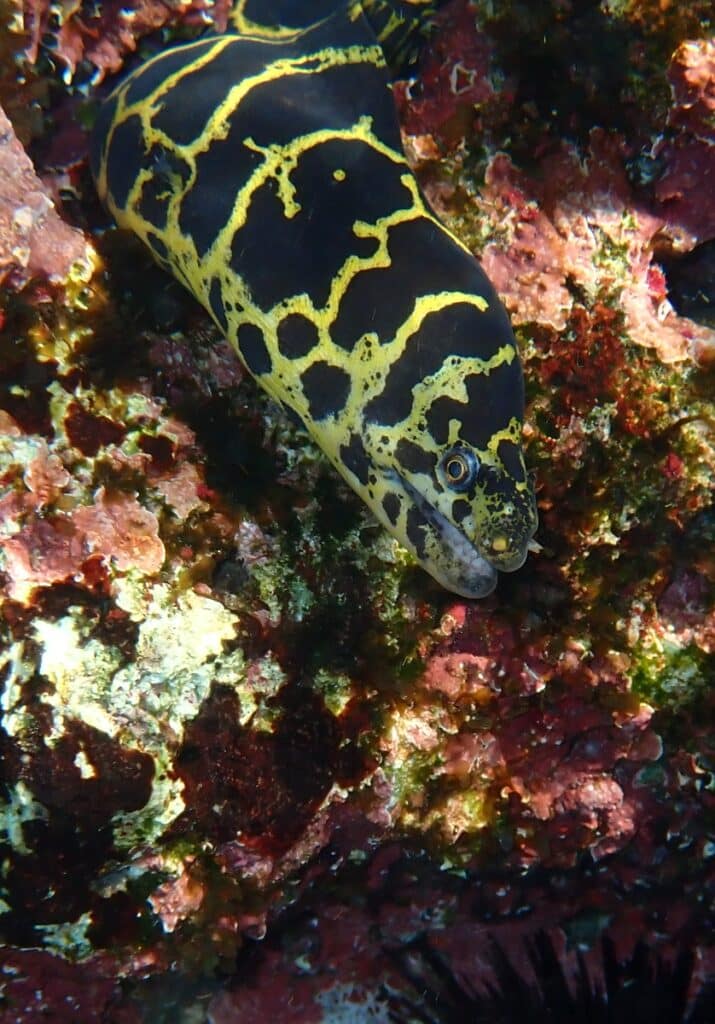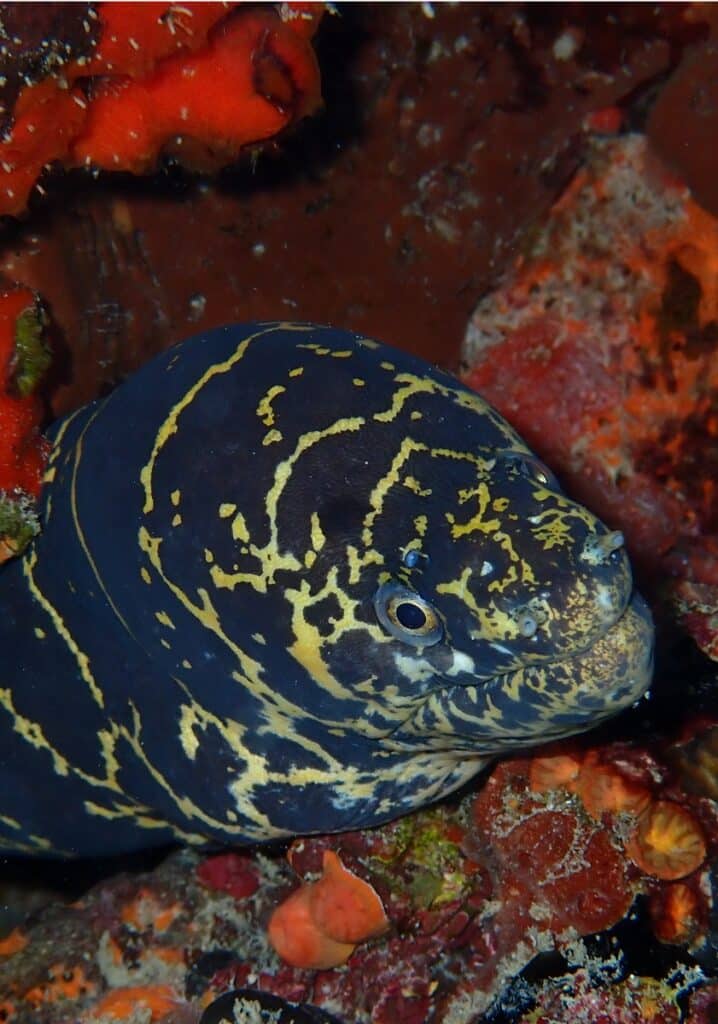Went snorkeling and saw a small eel sporting a beautiful pattern in yellow and black? Congrats, it sounds like you just met a chain moray eel! Unlike many other morays, this species, which is scientifically known as Echidna catenata, doesn’t tend to grow larger than 40 cm/16″.
Want to know more? Keep reading to find out everything you need to know about the chain moray eel, where you may come across it, its diet and much more!
Chain moray eel appearance
Originally described by German naturalist and ichthyologist Marcus Bloch in 1795, the chain moray eel is easy to recognize by its striking yellow and black/brownish “chain” pattern. This pattern is more pronounced in juveniles than adults.
Like all moray eels, this species has an elongated, snake-like body. Its eyes are yellow in color. It has no scales, instead relying on a mucus layer for skin protection.
The chain moray eel is one of the smaller members of the moray family Muraenidae. As mentioned in the intro, it usually doesn’t surpass 40 cm/16″, although one 1994 article does note individuals up to 165 cm/65″ in length.
| Name (common, scientific) | Chain moray eel, chain link eel, Echidna catenata |
| Family | Muraenidae |
| Spread | Western Atlantic |
| Habitat | Shallow reefs and rocky areas |

Chain moray eel habitat
This moray eel is native to the western Atlantic Ocean, although it has also been spotted around some of the islands in the eastern Atlantic, like Cape Verde. It’s found as far north as Florida and as far south as Brazil, and is very common in the Caribbean.
Because the chain moray eel mostly hangs around shallow waters with a maximum depth of around 15 m/50 ft, it’s a great candidate to look for while snorkeling. It spends much of its day holed up in rock crevices and other hides, so peek around any cracks and little caves you see (though, as always, don’t stick your hands in). You may just find a moray head sticking out.
In its natural range, this eel is considered a species of Least Concern by the IUCN. It’s quite common. I saw many while snorkeling around the Dutch Caribbean island of Curaçao! Don’t worry, they’re quite shy and not nearly as aggressive as some of their larger moray eel cousins.
Planning your next snorkel trip?

Chain moray eel diet
One cool thing about this species is that quite a lot of research has been done to investigate its feeding habits. We know a good bit about what it eats and how it hunts!
Preferred foods
Moray eels like this one may eat fish if they can catch them, but for many, their favorite food is actually invertebrates. The chain moray eel hunts both at night and during the day, relying mostly on scent and launching blitz attacks on unsuspecting crustaceans and cephalopods.
Unlike some other morays, which will eat anything from shrimp to octopi, the chain moray has a specific taste for crabs. According to Randall (2005), its more rounded teeth are perfectly designed to crush its prey’s shells into pieces. (By the way, Randall also noted a chain moray in a barracuda’s stomach – there’s always a bigger fish).
Hunting methods
The chain moray eel has a few different ways of hunting. For an easy catch, it may strike at crabs or other tasty morsels that have ventured too close to its hide. It will also sometimes slink out of its cave to stalk invertebrates that are a bit further off, occasionally chasing bugs for a bit if they try to make an escape.
If a quick meal isn’t available, the eel will come out of its lair to begin actively searching for food, poking its head into crevices and hides to try and find prey.
The species has been seen hunting in shallow tide pools, sometimes even leaving the water to try and catch a pesky crab that has managed to evade it! It relies heavily on its sight in order to detect movement and determine where to strike.
To help immobilize prey immediately, the eel uses a behavior that has been dubbed ‘knotting’. Once it’s managed to catch an unlucky crab or other creature, it rapidly jerks its head back and forms its body into a sort of knot, pulling its head through the loops. This pulls apart the prey or helps the eel swallow it in one go if it’s small enough. It may repeat the knot if necessary.
During my snorkel trip at Klein Curaçao, I was lucky enough to find a chain moray eel in the shallows. It was actively hunting crabs, specifically nimble spray crabs (Percnon gibbesi). Such a sight to see! The eel’s reflexes really are lightning-quick.
Did you know? One reason species like the chain moray are so effective at catching their food is because they’ve got two pairs of jaws. One’s for catching prey, the other’s for pulling it in! If that sounds similar to the Xenomorph in Alien… that’s because it is.
Chain moray eel facts
In the aquarium
Like some other moray eels, the chain moray sometimes makes its way into the aquarium trade. It’s not very common, but some (online) aquarium stores do sell small specimens for as little as $50.
As far as morays go, Echidna catenata is considered one of the easier species to care for. Due to its smaller size, it doesn’t make as much of a mess, and there’s also less of a risk of one chomping your fingers (although you should still be careful during feeding time).
If you’re interested in keeping a chain moray eel, remember that no moray does well in a small tank. You should keep yours in an aquarium of at least 125 gallons or preferably more, feeding twice or so a week. Live foods work best and should be easy enough to find, as most aquarium stores sell feeder shrimp, crayfish and crabs.
Moray eels are considered reef-safe: they won’t hunt sessile invertebrates like corals, only moving ones like shrimp.
Tip: If you want to keep any kind of moray eel in your aquarium, make sure the tank has a tight-fitting hood. Your eel may get the urge to go searching for food elsewhere, and since these guys are escape artists, they can easily end up on the floor!
If you have any more questions about the chain moray eel or if you’d like to share your own experiences with this colorful moray, don’t hesitate to leave a comment below!
Sources/further reading

